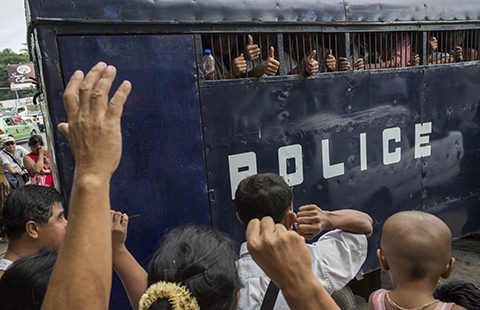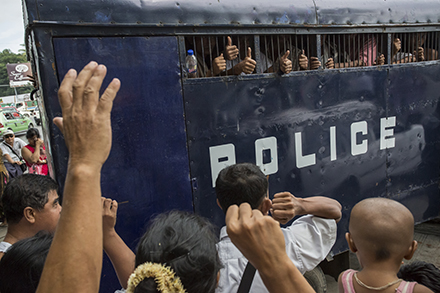A new study of Myanmar’s courts reveals the tensions between the rule of law and a focus on law and order.
Among the rapid economic and political changes underway in Myanmar, one concern still stands out starkly: the want of respect for the rule of law.
As the country moves from military to civilian rule, a lot of voices inside and outside the country are calling for “stronger rule of law”. People across Myanmar are responding to widely held views that courts are corrupt and inefficient, police abusive, government administrators capricious, and that military-backed cronies can literally do whatever they want, with impunity.
Efforts to uphold the rule of law, consensus opinion has it, will not only signal commitment to greater political and economic freedoms; it will also help to ensure that the country’s judicial institutions uphold human rights, be guided by fairness, oppose arbitrariness, pursue equity and provide justice.
It is in this context that a new book from ANU researcher Nick Cheesman is particularly illuminating. And it shows that the story of Myanmar isn’t at all what the rule of law’s proponents make it out to be. Nor, for that matter, is the story of the rule of law anywhere what we are often led to believe.
Opposing the rule of law: how Myanmar’s courts make law and order shows that while the rule of law might be held up as a common political ideal worldwide, we ought not be fooled into thinking that just because people talk about the rule of law, it means the same thing to them as it does to us.
In the book, which is the culmination of a multiple award-winning PhD thesis and the first significant study of the country’s courts, Cheesman argues that Myanmar is an instance of a country in which the rule of law is “lexically present but semantically absent”.
Instead of holding up the rule of law, Myanmar’s courts are characterised by a concern for law and order. And while the two terms are often used interchangeably, they are clearly not the same thing. It’s led to a complex and tense interplay with the demand for law on one side and the imperatives of order on the other.
A clear example of this was 2007’s so-called saffron revolution, which saw Burmese monks lead a wave of non-violent resistance against the country’s ruling regime. The peaceful protests were dealt with harshly by Myanmar’s then ruling military junta, with many of the protesters arrested and detained.
“The military government created anomalous spaces into which it could literally abduct and detain people outside of the ordinary criminal juridical institutions,” says Cheesman, who is co-convening the 2015 Myanmar/Burma Update conference taking place at ANU on 5-6 June.
“This kind of practice also happened in other countries in the region like Sri Lanka and Nepal, where mass disappearances occurred, and in those countries people never came back. But in Myanmar, people were returned through criminal trials.
“The Myanmar police or military, who were clearly violating law, could still send those people to court with the full understanding that the judges and prosecutors would do what was required of them.”
What was required was that courts act as gatekeepers of a juridical threshold across which could be taken at will, but from which they could be returned, through trial and sentencing.
“People could be abducted, disappeared into camps, processed and brought back through the criminal juridical process to be made into politically and legally relevant humans again.,” says Cheesman.
It’s an example of how law and order has subsumed the rule of law in Myanmar both as an idea and in practice. And while this occurred before Myanmar’s first steps away from military rule in 2008, as Cheesman points out, law and order is still a guiding idea for state practice in Myanmar; and this idea is asymmetrically opposed to the rule of law.
“It is asymmetrical because it is not a negative of the rule of law. It has its own distinctive contents. It is oppositional because whereas the rule of law relies on general rules to guide conduct and maintain order through judicial arrangements, law and order rests on specific directives delivered by administrators who intervene directly in people’s lives,” says Cheesman.
“In this respect, the government in Myanmar is not much different from counterparts elsewhere in the world who claim that law and order and the rule of law go hand-in- hand, and vigorously pursue the one on the pretext that their goal is the other.”
However, Cheesman is under no disillusion that the rule of law can be reconciled with law and order. According to him, not only do the two relate to law in profoundly different ways; they also differ fundamentally on the question of how to establish order. It is for this reason that he cautions against conflating one with the other.
“Law and order entails the external imposition of order. As a matter of principle, it insists on a relationship of political domination: somebody must impose order on somebody else,” says Cheesman.
“Under the rule of law, by contrast, order is an internal feature of political relations. It emerges out of those relations. It is not imposed.
“Whereas it makes sense for undemocratic governments like successive military juntas in Myanmar to subscribe to the idea of law and order, and pursue projects to realise it, for democracies to do so is foolhardy, and potentially dangerous.
“Far better instead to aspire to the rule of law.”
Opposing the rule of law is available from Cambridge University Press and will be launched at ANU on Friday 5 June as part of the 2015 Myanmar/Burma Update.
James Giggacher is editor of New Mandala and associate lecturer in the Coral Bell School of Asia Pacific Affairs, The Australian National University.
 Facebook
Facebook  Twitter
Twitter  Soundcloud
Soundcloud  Youtube
Youtube  Rss
Rss 
